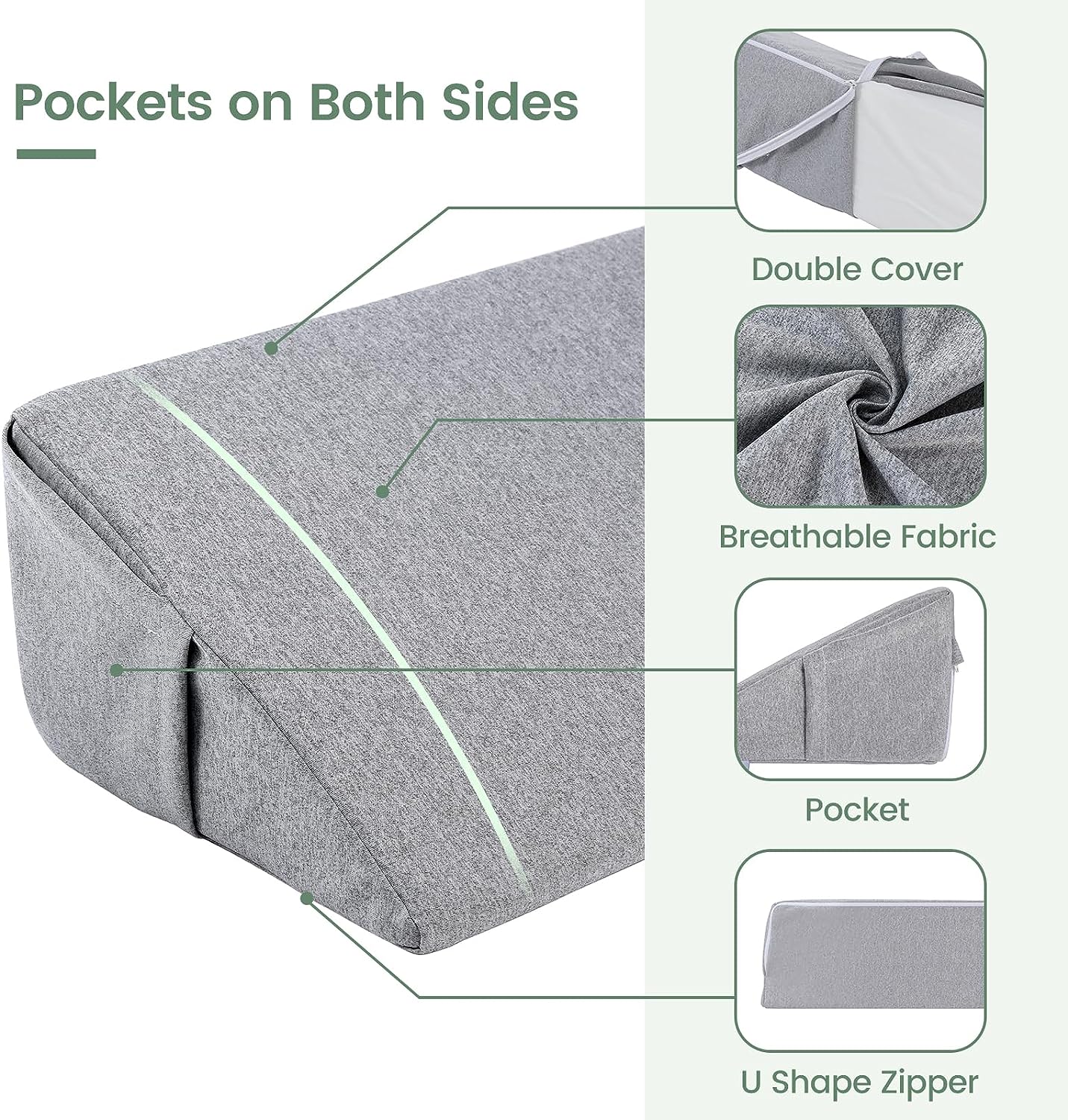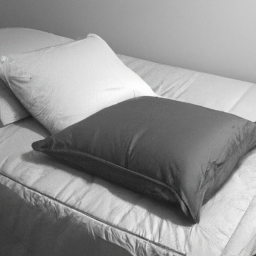In this article, we will be answering the commonly asked question – “How often should a wedge pillow be replaced?” We’ll provide you with some insights and factors to consider when determining the lifespan of your wedge pillow. Whether you’re using it for medical purposes or simply for comfort, we’ll guide you on when it’s time for a replacement. So, keep reading to find out more!
How Often Should A Wedge Pillow Be Replaced?
Wedge pillows are popular sleep aids that provide support and comfort for various purposes, such as relieving acid reflux, snoring, and reducing lower back pain. However, like any other bedding accessory, wedge pillows have a lifespan and require replacement over time. While there is no set rule for when to replace a wedge pillow, there are several factors to consider. In this article, we will explore the reasons to replace a wedge pillow, the factors affecting replacement frequency, recommended replacement timeframe, signs it’s time for a replacement, and tips for prolonging the lifespan of a wedge pillow.
Wear and Tear
One of the primary reasons to replace a wedge pillow is wear and tear. Over time, the constant use and pressure on the pillow can cause it to deteriorate. The materials may become worn out, resulting in a loss of support and comfort. Additionally, the pillow may start to show visible signs of damage, such as rips, tears, or fraying seams. These signs of wear and tear indicate that it’s time to invest in a new wedge pillow.
Loss of Support
As a wedge pillow ages, its ability to provide adequate support diminishes. The foam or filling materials may become less resilient, causing the pillow to flatten or sag. This loss of support can have negative effects on your sleep quality and overall comfort. When a wedge pillow no longer provides the necessary support for your body, it’s time for a replacement to ensure optimal sleep positioning and alignment.
Deterioration of Materials
The materials used in a wedge pillow can also deteriorate over time. Depending on the quality of the pillow, the cover fabric may wear out, become faded, or develop stains. Additionally, if you have allergies or sensitivities, the pillow’s materials may accumulate allergens or irritants over time, leading to increased discomfort or potential health issues. If you notice a decline in the pillow’s quality or experience an increase in allergic reactions, it’s a clear sign that it’s time for a replacement.
Factors Affecting Replacement Frequency
The frequency at which you need to replace your wedge pillow can vary depending on several factors. These factors include the materials used in the pillow, the frequency of use, and the weight and pressure applied to the pillow.
Materials Used
The choice of materials used in a wedge pillow can significantly influence its lifespan. High-quality memory foam is known for its durability and ability to retain its shape over extended periods. On the other hand, lower-quality foam or synthetic fillings may degrade more rapidly, leading to a shorter lifespan. Therefore, it’s essential to choose a wedge pillow made with high-quality materials to ensure longevity.
Frequency of Use
The more often you use your wedge pillow, the quicker it will wear out. If you rely on your wedge pillow for nightly sleep, it will likely undergo more wear and tear compared to occasional use for reading or watching TV. Those who use their wedge pillows as a primary sleep aid may need to replace them more frequently than those who use them sparingly.
Weight and Pressure Applied
The weight and pressure applied to a wedge pillow can also impact its lifespan. Heavier individuals or those who frequently shift their weight on the pillow may cause it to compress more rapidly. The increased pressure can lead to accelerated flattening and loss of support. Consider your body weight and sleeping habits when assessing the replacement frequency for your wedge pillow.
Recommended Replacement Timeframe
While there is no universal timeframe for replacing wedge pillows, there are general guidelines to follow. These guidelines can help you determine when it’s time to replace your current pillow. However, keep in mind that individual circumstances and preferences may vary.
General Guidelines
As a general rule of thumb, consider replacing your wedge pillow every 1 to 2 years. This timeframe ensures that you have a fresh, supportive pillow that promotes healthy sleep posture. If you notice significant wear and tear, loss of support, or deterioration of materials before this timeframe, consider replacing it sooner.
Specific Conditions
Certain conditions may require more frequent wedge pillow replacements. For example, individuals with respiratory conditions or allergies may need to replace their pillows more often to maintain a clean and allergen-free sleep environment. Similarly, if you have an existing medical condition that necessitates a wedge pillow, consult with your healthcare provider for specific recommendations on replacement frequency.
Determining Wear and Tear
To determine if your wedge pillow needs replacement, look for visible damage, flattening or sagging, and loss of shape.
Visible Damage
Inspect your wedge pillow for any visible signs of damage, such as rips, tears, or frayed seams. These damages can compromise the integrity of the pillow and affect its support and comfort. If you notice any visible damage, it’s time to consider replacing your pillow.
Flattening or Sagging
Over time, the foam or filling materials in a wedge pillow can lose their resilience and compress, resulting in flattening or sagging. If your pillow no longer retains its original shape and fails to provide the necessary support, it’s a clear indication that it needs to be replaced.
Loss of Shape
A wedge pillow should maintain its intended shape to effectively support your body. If you notice that the pillow has lost its shape or its incline is no longer as pronounced, it’s a sign that it’s no longer providing the proper support and should be replaced.
Loss of Support
The loss of support in a wedge pillow can have several consequences for your sleep and overall well-being.
Effects on Alignment
Wedge pillows are designed to promote proper alignment of the spine, neck, and head. When a pillow loses its support, it can compromise this alignment, potentially leading to discomfort or pain. If you find that your wedge pillow no longer keeps your body properly aligned, it’s time for a replacement.
Impact on Comfort
A worn-out wedge pillow will not provide the same level of comfort as a new one. As the materials deteriorate, you may experience uneven support, lumps, or a generally uncomfortable sleeping surface. If you find yourself tossing and turning or waking up with discomfort, a replacement pillow may be necessary to restore your comfort.
Potential Health Issues
An old wedge pillow that lacks support and harbors allergens can have adverse effects on your health. If you have respiratory conditions, allergies, or sensitivities, continued use of a worn-out pillow may exacerbate your symptoms or lead to new health issues. Prioritize your health and consider replacing your pillow to maintain a clean and supportive sleep environment.
Deterioration of Materials
The quality and durability of the materials used in a wedge pillow play a significant role in its overall lifespan and eventual need for replacement.
Quality and Durability
Investing in a high-quality wedge pillow made with durable materials can significantly extend its lifespan. Pillows made with superior memory foam, for example, are more likely to retain their shape and support over time. Consider the quality and durability of the materials when purchasing a wedge pillow to ensure that it will last longer before needing replacement.
Allergies and Sensitivities
For individuals with allergies or sensitivities, the accumulation of allergens or irritants in a wedge pillow can cause discomfort and potential health issues. Lower-quality pillows may be more prone to harboring allergens, such as dust mites or mold. If you find that your allergies worsen or your sensitivities are heightened, it may be time to replace your pillow with a hypoallergenic option.
Hygiene Concerns
As with any bedding accessory, hygiene is crucial for maintaining a healthy sleeping environment. Over time, a wedge pillow can accumulate sweat, oils, and skin cells, providing an ideal environment for bacteria or mold growth. Regular cleaning and maintenance can help prolong the pillow’s lifespan, but if hygiene concerns persist or become difficult to manage, it may be time to replace the pillow.
Prolonging the Lifespan of a Wedge Pillow
While wedge pillows do have a finite lifespan, there are steps you can take to prolong their usability.
Proper Cleaning and Maintenance
Regularly cleaning and maintaining your wedge pillow can help extend its lifespan. Follow the manufacturer’s cleaning instructions, which typically involve spot cleaning the cover and occasional gentle hand washing. Use a protective cover to shield the pillow from sweat, oils, and allergens. Proper maintenance can help prevent the deterioration of materials and promote hygiene.
Usage Guidelines
Using your wedge pillow correctly is essential for its longevity. Avoid excessive bending or folding of the pillow, as this can compromise its shape and support. Be mindful of its weight capacity, if specified by the manufacturer, to prevent excessive compression. Additionally, use the pillow primarily for its intended purpose, whether it’s elevating your upper body for sleep or providing support during specific activities.
Protective Covers
Investing in protective covers for your wedge pillow can help safeguard it against spills, stains, allergens, and dust mites. These covers create a barrier between you and the pillow, making it easier to keep it clean and prolong its lifespan. Look for hypoallergenic or waterproof covers that are easy to remove and wash.
Signs It’s Time to Replace Your Wedge Pillow
While the recommended replacement timeframe provides a general guideline, there are signs you can look for that indicate it’s time to replace your wedge pillow.
Persistent Discomfort
If you consistently experience discomfort or pain while using your wedge pillow, even after trying various sleep positions, it may be a sign that the pillow has lost its support or shape. Don’t ignore persistent discomfort, as it can impact your sleep quality and overall well-being.
Lack of Support
A wedge pillow should provide adequate support to keep your body properly aligned during sleep. If you feel that your current pillow no longer offers the desired support, it’s time to evaluate its condition and consider a replacement. Proper support is essential for alleviating various sleep issues and maintaining optimal sleep posture.
Increased Allergic Reactions
If you experience an increase in allergic reactions, respiratory issues, or sensitivities while using your wedge pillow, it may be a sign that the materials have deteriorated and accumulated allergens or irritants. In such cases, replacing the pillow with a hypoallergenic option can help alleviate your symptoms and create a healthier sleep environment.
When in Doubt, Consult the Manufacturer
If you’re unsure about whether to replace your wedge pillow, it’s always a good idea to consult the manufacturer for guidance.
Contacting Customer Support
Reach out to the manufacturer’s customer support team and provide them with the necessary details about your pillow, such as the purchase date, the materials used, and any visible signs of wear and tear. They can offer expert advice on whether it’s time for a replacement or if there are additional steps you can take to restore the pillow’s functionality.
Warranty Information
If your wedge pillow is covered by a warranty, consult the warranty documentation or contact the manufacturer to understand any specific guidelines or provisions regarding replacement. Some warranties may offer a replacement option within a certain timeframe or cover defects that affect the pillow’s performance.
Expert Advice
If you have specific medical conditions or concerns related to the use of a wedge pillow, seek advice from a healthcare professional. They can offer personalized recommendations based on your needs and help determine when a replacement is necessary. Healthcare providers with experience in sleep medicine or orthopedics may have particular insights into wedge pillows and their lifespan.

Conclusion
To ensure optimal comfort, support, and hygiene, it’s important to replace your wedge pillow when it shows signs of wear and tear, loss of support, or deterioration of materials. While there are general guidelines for replacement timeframe, factors such as materials used, frequency of use, and weight and pressure applied can influence the need for replacement. By keeping an eye out for visible damage, flattening or sagging, and loss of shape, you can determine when it’s time for a replacement. Prolong the lifespan of your wedge pillow by practicing proper cleaning and maintenance, following usage guidelines, and using protective covers. Remember, your comfort, support, and overall health should be a priority when it comes to replacing your wedge pillow.



